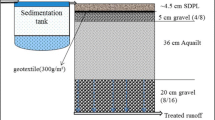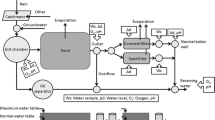Abstract
Urban stormwater can be treated by infiltration at the source using systems like permeable paving. A critical component of such a system is the filtration media. Laboratory experiments were conducted using columns and boxes to evaluate the sediment retention efficiencies of different filtration media—crushed Greywacke, Greywacke mixed with 10% sand, and layered Greywacke and sand-Greywacke mix. Sediments of 0.001–6 mm were applied at concentrations of 460–4,200 mg/l along with water at flow rates of 100–900 ml/min. All columns showed between 96 and 91% sediment retention efficiency for single dry sediment applications, with lowered sediment retentions at higher flow rates. Decreasing the sediment loading, applying particles of <38 μm size, and suspending the particles in inflow as opposed to directly applying sediments to the column surface gave lower sediment retention efficiencies of 55 to 89%. Sediment retention primarily occurred in the top 20 mm of all columns and the 50th percentile value of retained sediments was 100–300 μm. The box tests showed little effect of flow and sediment loading on particle retention, with the tests showing an average retention of 93%. Similar to the column tests, the box tests showed lower sediment retention (84 to 88%) for <38 μm sediments and greater retention (approximately 95%) for larger sediments.









Similar content being viewed by others
References
Bornatici, L., Ciaponi, C., & Papiri, S. (2004). Control of urban runoff stormwater discharge to receiving waters using off-line storage. In J. Marsalek, et al. (Ed.) Enhancing urban environment by environmental upgrading and restoration (pp. 33–44). Netherlands: Kluwer.
Borst, M., & Selvakumar, A. (2003). Particle-associated microorganisms in stormwater runoff. Water Research, 37(1), 215–223.
Casey, R. E., Simon, J. A., Atueyi, S., Snodgrass, J. W., Karouna-Renier, N., & Sparling, D. W. (2006). Temporal trends of trace metals in sediment and invertebrates from stormwater management ponds. Water, Air, and Soil Pollution, 178, 69–77.
Dempsey, B. A., & Swisher, D. M. (2003). Evaluation of porous pavement and infiltration in centre county, PA. World Water & Environmental Resources Congress 2003, Philadelphia, USA.
Dempsey, B. A., Tai, Y., & Harrison, S. (1993). Mobilization and removal of contaminants associated with urban dust and dirt. University Park, PA: Pennsylvania State University.
Elliott, A. H., & Trowsdale, S. A. (2007). A review of models for low impact urban stormwater drainage. Environmental Modelling & Software, 22, 394–405.
Hossain, M. A., Alam, M., Yonge, D. R., & Dutta, P. (2005). Efficiency and flow regime of a highway stormwater detention pond in Washington, USA. Water, Air, and Soil Pollution, 164, 79–89.
Interpave (2003). Permeable pavement guide to the design construction and maintenance of concrete block permeable pavements. UK: The Precast Concrete Paving & Kerb Association.
Muthanna, T. M., Viklander, M., Gjesdahl, N., & Thorolfsson, S. T. (2007). Heavy metal removal in cold climate bioretention. Water, Air, and Soil Pollution, 183, 391–402.
Muthukaruppan, M., Chiew, F., & Wong, T. (2002). Size distribution and partitioning of urban pollutants. In Proceedings of 9th International Conference of Urban Drainage in Portland, Florida, USA.
Ng, W. H., Buckeridge, J. S., & Ockleston, G. (2003, May). Distribution of heavy metal contaminants in road sediments. In Proceedings of the 3rd South Pacific Stormwater Conference, Auckland, New Zealand.
Pratt, C. J., Wilson, S., & Cooper, P. (2002). Source control using constructed pervious surfaces, hydraulic, structural and water quality issues. London, UK: CIRIA, Construction Industry Research and Information Association.
Smith, E. (2001). Pollutant concentrations of stormwater and captured sediment in flood control sumps draining an urban watershed. Water Research, 35(13), 3117–3126.
Sorme, L., & Lagerkvist, R. (2002). Sources of heavy metals in urban wastewater in Stockholm. Science of The Total Environment, 298(1–3), 131–145.
Vaze, J., & Francis, C. (2002). Experimental study of pollutant accumulation on an urban road surface. Urban Water, 4(4), 379–389.
Walker, T. A., Allison, R. A., Wong, T. H. F., & Wootton, R. M. (1999). Removal of suspended solids and associated pollutants by a CDC gross pollutant trap. Victoria, Australia: Co-operative Research Centre for Catchment Hydrology.
Acknowledgement
The authors acknowledge the funding from Stevensons Ltd and Technology New Zealand for supporting the study.
Author information
Authors and Affiliations
Corresponding author
Rights and permissions
About this article
Cite this article
Singhal, N., Elefsiniotis, T., Weeraratne, N. et al. Sediment Retention by Alternative Filtration Media Configurations in Stormwater Treatment. Water Air Soil Pollut 187, 173–180 (2008). https://doi.org/10.1007/s11270-007-9506-x
Received:
Accepted:
Published:
Issue Date:
DOI: https://doi.org/10.1007/s11270-007-9506-x




